Small overlap front: driver-side
Rating applies to 2017-19 models built after August 2017
Tested vehicle: 2017 Nissan Titan SV Crew Cab
The Nissan Titan Crew Cab (light duty pickup with gasoline engine) was redesigned for the 2017 model year after a one-year absence from the market. Beginning with 2017 models built after August 2017, the front-end structure was modified to improve occupant protection in small overlap crashes. (Information about when a specific vehicle was manufactured is on the certification label typically affixed to the car on the driver door or adjacent B-pillar.)
| Evaluation criteria | Rating |
|---|---|
| Structure and safety cage | |
| Driver injury measures | |
| Head/neck | |
| Chest | |
| Hip/thigh | |
| Lower leg/foot | |
| Driver restraints and dummy kinematics | |

Action shot taken during the driver-side small overlap frontal crash test of the 2017 Nissan Titan built after August 2017.
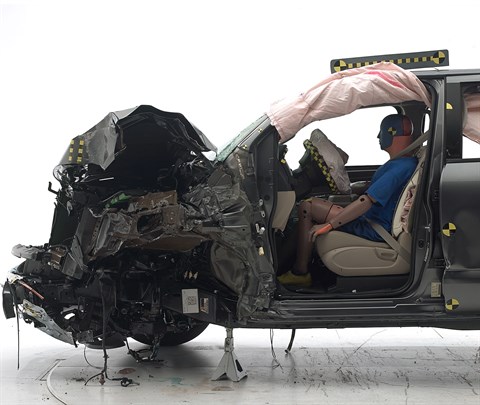
The dummy's position in relation to the door frame, steering wheel, and instrument panel after the crash test indicates that the driver's survival space was maintained well.
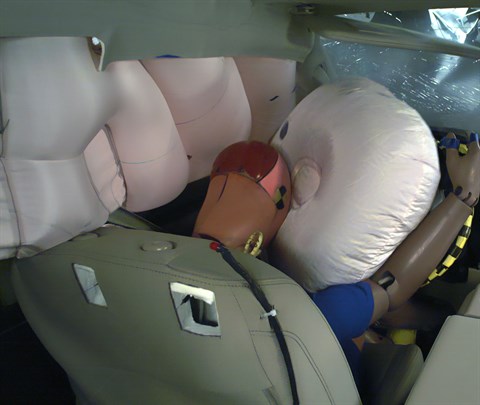
The frontal and side curtain airbags worked well together to keep the head from coming close to any stiff structure or outside objects that could cause injury.

Forces on the left lower leg were high enough to indicate moderate risk of injury.
Measures of occupant compartment intrusion on driver side
| Evaluation criteria | Measurement |
|---|---|
| Test ID | CEN1724 |
| Lower occupant compartment | |
| Lower hinge pillar max (cm) | 17 |
| Footrest (cm) | 14 |
| Left toepan (cm) | 7 |
| Brake pedal (cm) | 9 |
| Parking brake (cm) | 15 |
| Rocker panel lateral average (cm) | 5 |
| Upper occupant compartment | |
| Steering column | 3 |
| Upper hinge pillar max (cm) | 7 |
| Upper dash (cm) | 7 |
| Lower instrument panel (cm) | 7 |
Driver injury measures
| Evaluation criteria | Measurement |
|---|---|
| Test ID | CEN1724 |
| Head | |
| HIC-15 | 104 |
| Peak gs at hard contact | no contact |
| Neck | |
| Tension (kN) | 1.1 |
| Extension bending moment (Nm) | 13 |
| Maximum Nij | 0.38 |
| Chest maximum compression (mm) | 24 |
| Femur (kN) | |
| Left | 0.6 |
| Right | 0.8 |
| Knee displacement (mm) | |
| Left | 1 |
| Right | 2 |
| Knee-thigh-hip injury risk (%) | |
| Left | 0 |
| Right | 0 |
| Maximum tibia index | |
| Left | 0.00 |
| Right | 0.48 |
| Tibia axial force (kN) | |
| Left | 0.0 |
| Right | 0.6 |
| Foot acceleration (g) | |
| Left | 72 |
| Right | 40 |
Small overlap front: passenger-side
Rating applies to 2017-19 models built after August 2017
Tested vehicle: 2018 Nissan Titan SV Crew Cab
The Nissan Titan (light duty pickup with gasoline engine) was redesigned for the 2017 model year after a one-year absence from the market. Beginning with 2017 models built after August 2017, the front-end structure was modified to improve occupant protection in small overlap crashes. (Information about when a specific vehicle was manufactured is on the certification label typically affixed to the car on the driver door or adjacent B-pillar.)
| Evaluation criteria | Rating |
|---|---|
| Overall evaluation | |
| Structure and safety cage | |
| Passenger injury measures | |
| Head/neck | |
| Chest | |
| Hip/thigh | |
| Lower leg/foot | |
| Passenger restraints and dummy kinematics | |
| Driver injury measures | |
| Head/neck | |
| Chest | |
| Hip/thigh | |
| Lower leg/foot | |
| Driver restraints and dummy kinematics | |

Action shot taken during the passenger-side small overlap frontal crash test.
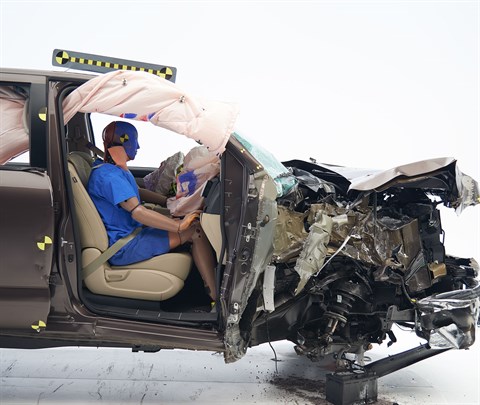
The dummy's position in relation to the door frame and dashboard after the crash test indicates that the passenger’s survival space was maintained reasonably well.
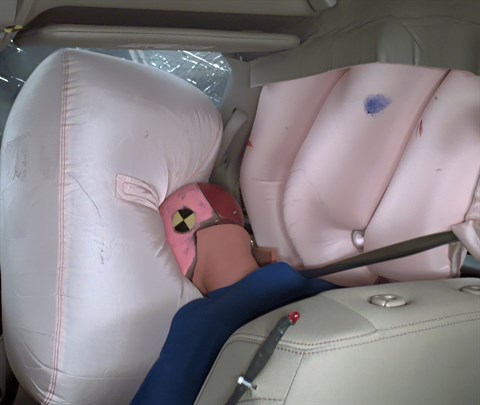
The frontal and side curtain airbags worked well together to keep the passenger dummy’s head from coming close to any stiff structure or outside objects that could cause injury.
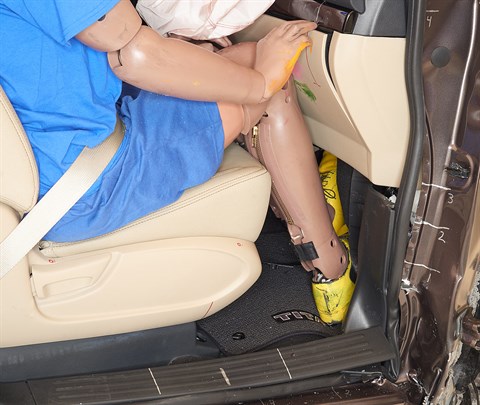
Despite intrusion of the footwell and dashboard, risk of injuries to the dummy's legs and feet was low.
Measures of occupant compartment intrusion on passenger side
| Evaluation criteria | Measurement |
|---|---|
| Test ID | CEP1821 |
| Lower occupant compartment | |
| Lower hinge pillar max (cm) | 17 |
| Footrest (cm) | 28 |
| Right toepan (cm) | 23 |
| Center toepan (cm) | 16 |
| Rocker panel lateral average (cm) | 3 |
| Upper occupant compartment | |
| Center dash (cm) | 7 |
| Upper hinge pillar max (cm) | 10 |
| Upper dash (cm) | 9 |
| Right lower dash (cm) | 9 |
Passenger injury measures
| Evaluation criteria | Measurement |
|---|---|
| Test ID | CEP1821 |
| Head | |
| HIC-15 | 278 |
| Peak gs at hard contact | no contact |
| Neck | |
| Tension (kN) | 0.9 |
| Extension bending moment (Nm) | 12 |
| Maximum Nij | 0.15 |
| Chest maximum compression (mm) | 16 |
| Femur (kN) | |
| Left | 2.8 |
| Right | 5.2 |
| Knee displacement (mm) | |
| Left | 7 |
| Right | 0 |
| Knee-thigh-hip injury risk (%) | |
| Left | 0 |
| Right | 5 |
| Maximum tibia index | |
| Left | 0.70 |
| Right | 0.53 |
| Tibia axial force (kN) | |
| Left | 2.4 |
| Right | 1.5 |
| Foot acceleration (g) | |
| Left | 65 |
| Right | 51 |
Driver injury measures
| Evaluation criteria | Measurement |
|---|---|
| Test ID | CEP1821 |
| Head | |
| HIC-15 | 70 |
| Peak gs at hard contact | no contact |
| Neck | |
| Tension (kN) | 0.8 |
| Extension bending moment (Nm) | 18 |
| Maximum Nij | 0.19 |
| Chest maximum compression (mm) | 32 |
| Femur (kN) | |
| Left | 0.5 |
| Right | 0.1 |
| Knee displacement (mm) | |
| Left | 5 |
| Right | 1 |
| Knee-thigh-hip injury risk (%) | |
| Left | 0 |
| Right | 0 |
| Maximum tibia index | |
| Left | 0.48 |
| Right | 0.25 |
| Tibia axial force (kN) | |
| Left | 0.4 |
| Right | 0.4 |
| Foot acceleration (g) | |
| Left | 28 |
| Right | 75 |
Moderate overlap front: original test
Rating applies to 2017-19 models
Tested vehicle: 2017 Nissan Titan S Crew Cab
The Nissan Titan Crew Cab (light duty pickup with gasoline engine) was redesigned for the 2017 model year after a one-year absence from the market. Moderate overlap frontal ratings are assigned by the Institute based on a test conducted by Nissan.
| Evaluation criteria | Rating |
|---|---|
| Overall evaluation | |
| Structure and safety cage | |
| Driver injury measures | |
| Head/neck | |
| Chest | |
| Leg/foot, left | |
| Leg/foot, right | |
| Driver restraints and dummy kinematics | |
Measures of occupant compartment intrusion on driver side
| Evaluation criteria | Measurement |
|---|---|
| Test ID | VTF1622 |
| Footwell intrusion | |
| Footrest (cm) | 4 |
| Left (cm) | 3 |
| Center (cm) | 3 |
| Right (cm) | 3 |
| Brake pedal (cm) | 3 |
| Instrument panel rearward movement | |
| Left (cm) | 1 |
| Right (cm) | 0 |
| Steering column movement | |
| Upward (cm) | 3 |
| Rearward (cm) | 1 |
| A-pillar rearward movement (cm) | 1 |
Driver injury measures
| Evaluation criteria | Measurement |
|---|---|
| Test ID | VTF1622 |
| Head | |
| HIC-15 | 222 |
| Peak gs at hard contact | no contact |
| Neck | |
| Tension (kN) | 1.2 |
| Extension bending moment (Nm) | 28 |
| Maximum Nij | 0.25 |
| Chest maximum compression (mm) | 29 |
| Legs | |
| Femur force - left (kN) | 1.0 |
| Femur force - right (kN) | 0.1 |
| Knee displacement - left (mm) | 10 |
| Knee displacement - right (mm) | 0 |
| Maximum tibia index - left | 0.70 |
| Maximum tibia index - right | 0.37 |
| Tibia axial force - left (kN) | 1.7 |
| Tibia axial force - right (kN) | 1.2 |
| Foot acceleration (g) | |
| Left | 44 |
| Right | 93 |
Side: original test
Rating applies to 2017-19 models
Tested vehicle: 2017 Nissan Titan SV Crew Cab
The Nissan Titan Crew Cab (light duty pickup with gasoline engine) was redesigned for the 2017 model year after a one-year absence from the market.
| Evaluation criteria | Rating |
|---|---|
| Overall evaluation | |
| Structure and safety cage | |
| Driver injury measures | |
| Head/neck | |
| Torso | |
| Pelvis/leg | |
| Driver head protection | |
| Rear passenger injury measures | |
| Head/neck | |
| Torso | |
| Pelvis/leg | |
| Rear passenger head protection | |
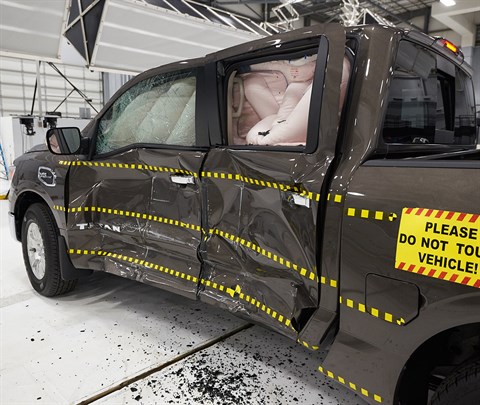
View of the vehicle just after the crash test.

View of the vehicle after the crash with doors removed, showing the side airbags and damage to the occupant compartment.

Smeared greasepaint shows where the driver dummy's head was protected from being hit by hard structures by the side airbags.
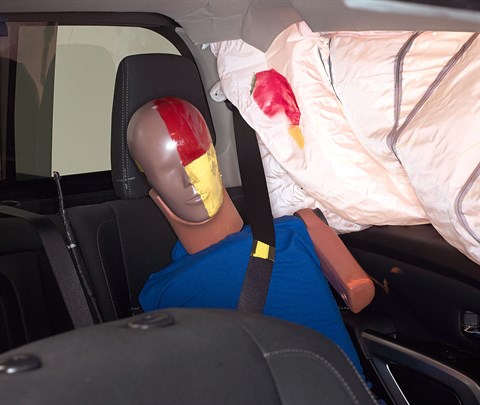
Smeared greasepaint shows where the rear passenger dummy’s head was protected by the side airbag.
Measures of occupant compartment intrusion on driver side
| Test ID | CES1615 |
|---|---|
| B-pillar to longitudinal centerline of driver's seat (cm) | -12.5 |
| Negative numbers indicate the amount by which the crush stopped short of the seat centerline. | |
Driver injury measures
| Evaluation criteria | Measurement |
|---|---|
| Test ID | CES1615 |
| Head HIC-15 | 147 |
| Neck | |
| Tension (kN) | 1.4 |
| Compression (kN) | 1.2 |
| Shoulder | |
| Lateral deflection (mm) | 49 |
| Lateral force (kN) | 1.8 |
| Torso | |
| Maximum deflection (mm) | 40 |
| Average deflection (mm) | 36 |
| Maximum deflection rate (m/s) | 4.25 |
| Maximum viscous criterion (m/s) | 0.73 |
| Pelvis | |
| Iliac force (kN) | 1.5 |
| Acetabulum force (kN) | 1.6 |
| Combined force (kN) | 3.0 |
| Left femur | |
| L-M force (kN) | 0.6 |
| L-M moment (Nm) | 85 |
| A-P moment (Nm) | 12 |
Passenger injury measures
| Evaluation criteria | Measurement |
|---|---|
| Test ID | CES1615 |
| Head HIC-15 | 53 |
| Neck | |
| Tension (kN) | 0.2 |
| Compression (kN) | 0.3 |
| Shoulder | |
| Lateral deflection (mm) | 21 |
| Lateral force (kN) | 1.0 |
| Torso | |
| Maximum deflection (mm) | 41 |
| Average deflection (mm) | 31 |
| Maximum deflection rate (m/s) | 3.60 |
| Maximum viscous criterion (m/s) | 0.66 |
| Pelvis | |
| Iliac force (kN) | 0.0 |
| Acetabulum force (kN) | 1.6 |
| Combined force (kN) | 1.6 |
| Left femur | |
| L-M force (kN) | 0.8 |
| L-M moment (Nm) | 38 |
| A-P moment (Nm) | -34 |
Roof strength
Rating applies to 2017-23 models
Tested vehicle: 2017 Nissan Titan SV Crew Cab
| Overall evaluation | |
|---|---|
| Curb weight | 5,460 lbs |
| Peak force | 24,857 lbs |
| Strength-to-weight ratio | 4.55 |
Head restraints & seats
Seat type: Manual cloth seat
| Overall evaluation | |
|---|---|
| Dynamic rating | |
| Seat/head restraint geometry |
| Seat type | Manual cloth seat |
|---|---|
| Geometry | |
| Backset (mm) | 30 |
| Distance below top of head (mm) | 18 |
| Seat design parameters | |
| Pass/fail | Pass |
| Max T1 acceleration (g) | 14.4 |
| Head contact time (ms) | 52 |
| Force rating | 1 |
| Neck forces | |
| Max neck shear force (N) | 0 |
| Max neck tension (N) | 379 |
About the head restraint & seat test
Currently, IIHS tests apply only to front seats.
Headlights
Ratings are given for 2 different headlight variations available on this vehicle.
Trim level(s)
- S trim
- SV trim
| Evaluation criteria | Rating |
|---|---|
| Low-beam headlight type | Halogen reflector |
| High-beam headlight type | Halogen reflector |
| Curve-adaptive? | No |
| High-beam assist? | No |
|
Overall rating | |
| Distance at which headlights provide at least 5 lux illumination: | |
Low beams
On the straightaway, visibility was fair on both sides of the road. On curves, visibility was inadequate in all 4 tests.
The low beams never exceeded glare limits.
High beams
On the straightaway, visibility was good on the right side of the road and inadequate on the left side. On curves, visibility was inadequate in all 4 tests.
| Evaluation criteria | Measurement |
|---|---|
| Trim level(s) |
|
| Low-beam headlight type | Halogen reflector |
| High-beam headlight type | Halogen reflector |
| Curve-adaptive? | No |
| High-beam assist? | No |
|
Overall rating Applies to 2017-19 models |
| LOW BEAMS | Average minimum useful illumination distance (5 lux) |
Amount glare exceeded threshold |
|---|---|---|
| Straightaway right edge | 80.9 m | None |
| Straightaway left edge | 50.8 m | None |
| 250m radius right curve, right edge | 48.4 m | None |
| 250m radius left curve, left edge | 47.4 m | None |
| 150m radius right curve, right edge | 44.5 m | None |
| 150m radius left curve, left edge | 44.3 m | None |
| HIGH BEAMS | Average minimum useful illumination distance (5 lux) |
|---|---|
| Straightaway right edge | 146.6 m |
| Straightaway left edge | 121.4 m |
| 250m radius right curve, right edge | 61.5 m |
| 250m radius left curve, left edge | 63.4 m |
| 150m radius right curve, right edge | 49.3 m |
| 150m radius left curve, left edge | 51.8 m |
Trim level(s)
- Pro 4X trim
- SL trim
- Platinum trim
| Evaluation criteria | Rating |
|---|---|
| Low-beam headlight type | LED projector |
| High-beam headlight type | Halogen reflector |
| Curve-adaptive? | No |
| High-beam assist? | No |
|
Overall rating | |
| Distance at which headlights provide at least 5 lux illumination: | |
Low beams
On the straightaway, visibility was fair on both sides of the road. On curves, visibility was fair on the sharp right curve and inadequate on the gradual right and both left curves.
The low beams created some glare.
High beams
On the straightaway, visibility was good on the right side of the road and inadequate on the left side. On curves, visibility was fair on the gradual right curve and inadequate on the sharp right and both left curves.
| Evaluation criteria | Measurement |
|---|---|
| Trim level(s) |
|
| Low-beam headlight type | LED projector |
| High-beam headlight type | Halogen reflector |
| Curve-adaptive? | No |
| High-beam assist? | No |
|
Overall rating Applies to 2017-19 models |
| LOW BEAMS | Average minimum useful illumination distance (5 lux) |
Amount glare exceeded threshold |
|---|---|---|
| Straightaway right edge | 81.4 m | None |
| Straightaway left edge | 51.5 m | None |
| 250m radius right curve, right edge | 52.7 m | None |
| 250m radius left curve, left edge | 47.0 m | None |
| 150m radius right curve, right edge | 46.3 m | 23.4% |
| 150m radius left curve, left edge | 43.5 m | None |
| HIGH BEAMS | Average minimum useful illumination distance (5 lux) |
|---|---|
| Straightaway right edge | 152.4 m |
| Straightaway left edge | 100.5 m |
| 250m radius right curve, right edge | 68.6 m |
| 250m radius left curve, left edge | 62.7 m |
| 150m radius right curve, right edge | 52.1 m |
| 150m radius left curve, left edge | 49.1 m |
Child seat anchors
Rating applies to 2017-19 models
| Evaluation criteria | Rating |
|---|---|
| Overall evaluation | |
| Vehicle trim | SV |
| Seat type | cloth |
This vehicle has 2 rear seating positions with complete child seat attachment (LATCH) hardware.
It has 1 additional seating position with a tether anchor only.
| Evaluation criteria | Rating |
|---|---|
| Overall evaluation | |
| Vehicle trim | SV |
| Seat type | cloth |
| Rating icon | Rating |
|---|---|
| G | Good |
| A | Acceptable |
| M | Marginal |
| P | Poor |
| Seating positions that rely on borrowed lower anchors or have only a tether anchor available are not rated. | |
thether anchor symbol | Tether anchor |
lower anchor symbol | Lower anchors |
| Lower anchor(s) can be borrowed from adjacent positions(s) | |
| No hardware available |
Details by seating position
| Position | Rating |
|---|---|
| 1 | |
| Tether anchor | |
| hard-to-find location | |
| no other hardware could be confused for anchor | |
| Lower anchors | |
| not too deep in seat | |
| too much force needed to attach | |
| easy to maneuver around anchors | |
| 2 | |
| Tether anchor | |
| hard-to-find location | |
| no other hardware could be confused for anchor | |
| Lower anchors | |
| none available | |
| 3 | |
| Tether anchor | |
| hard-to-find location | |
| no other hardware could be confused for anchor | |
| Lower anchors | |
| not too deep in seat | |
| too much force needed to attach | |
| easy to maneuver around anchors |
Seat position 21
| Lower anchor A | |
|---|---|
| Open access rated | No |
| Depth (cm) | 0-2 |
| Force (lbs) | could not measure |
| Clearance angle (degrees) | 74 |
| Lower anchor B | |
| Open access rated | No |
| Depth (cm) | 0-2 |
| Force (lbs) | could not measure |
| Clearance angle (degrees) | 79 |
| Tether anchor | |
| Location | Back wall |
| Confusing hardware present | No |
| Has contrasting label within 3 inches of tether anchor |
No |
| Tether anchors can be accessed while seatback is properly positioned for use of LATCH |
Not measured |
Seat position 22
| Lower anchor A | |
|---|---|
| No lower latch for this seat position | |
| Lower anchor B | |
| No lower latch for this seat position | |
| Tether anchor | |
| Location | Back wall |
| Confusing hardware present | No |
| Has contrasting label within 3 inches of tether anchor |
No |
| Tether anchors can be accessed while seatback is properly positioned for use of LATCH |
Not measured |
Seat position 23
| Lower anchor A | |
|---|---|
| Open access rated | No |
| Depth (cm) | 0-2 |
| Force (lbs) | could not measure |
| Clearance angle (degrees) | 73 |
| Lower anchor B | |
| Open access rated | No |
| Depth (cm) | 0-2 |
| Force (lbs) | could not measure |
| Clearance angle (degrees) | 70 |
| Tether anchor | |
| Location | Back wall |
| Confusing hardware present | No |
| Has contrasting label within 3 inches of tether anchor |
No |
| Tether anchors can be accessed while seatback is properly positioned for use of LATCH |
Not measured |
